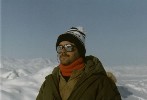|
Interested in a fun-filled exciting vacation? Try the North Pole.
- The New York Times
Vacation at the North Pole? Well, it's hard to get a good tan in the arctic.
But then, you'd never get to see a polar bear in Bermuda, or arctic wolves
and musk oxen, or Eskimos and caribou, for that matter.
So why did Bob Antol answer this advertisement and opt for the dangers of pack
ice and snow fields when most of us would rather be in the sun, sipping
lemonade?
"I like winter," says Antol. "I do a lot
of hiking in the mountains, and when I saw the ad in the New York Times, I
thought, 'Hey, this could be fun.' Here was the chance to do something few
people in all of history have ever done - walk at the top of the world."
The adventure began on April 18, 1985 when Antol, EDS
(Engineering Design System) physical
design user liaison at IBM East Fishkill, left building 503 for Edmonton,
Canada where he met his companions for the journey. Among them were a retired
Catholic priest from London, England, a 78-year old woman from Virginia, and
two National Geographic writers, who were assigned to do a story on
the arctic wolf.
Five days later, the party left Lake Hazen, the world's northernmost lake in
two Twin Otter (short-takeoff and short-landing planes), and headed for the
pole.
Reaching their destination was terribly exciting, Antol recalls.
"One of our people went up front to watch the instrument
readout. When it read 90-degrees north, he yelled, 'We're here.' We all
looked out the window. Suddenly, the plane began to circle."
Because the ice around the pole is constantly moving, the pilot had to
|
locate a pack smooth enough on which to land.
"Finally, we found an area that looked secure. Circling it,
searching the shadows, we skimmed just above the ice," Antol says.
When the pilot decided it was safe, they stopped. Antol stepped down from
the plane and onto the North Pole.
"The pole wasn't what I expected. I thought it would be a
flat wasteland. I was wrong. This was the most beautiful site I had ever
seen.
"Ridges surrounded us. We were trapped on a floating polar
ice pack with huge chunks of ice sticking from the pole."
As is traditional, the party planted a marker and pictures were taken. To
celebrate their arrival, they popped open a bottle of champagne.
The 20-below-zero temperature (Fahrenheit) was actually quite nice. Antol
says, considering what the party had been through the days before.
"I placed my plastic glass on the ice while I took some
pictures. When I picked it up in a matter of four minutes, it had frozen.
It tasted very cold, very good."
After the festivities, Antol began to explore. What struck him most were the
colors in the ice, ranging from dark blue to turquoise. "And
the prettiest, deepest blue sky I had ever seen." he says.
At one point, he stopped to change film in his camera. After finishing, he
turned to find his spare film on the ice. The three bands holding the film
had frozen, allowing it to slip out. "You can't trust a
simple thing like elastic in the cold of the arctic. It becomes brittle.
Camera straps freeze like swords and their shutters lock."
|
|
Another striking sight for Antol was the solid, dry snow. "It
filled in hollows, creating flat surfaces with undetectable holes
underneath, he says. Walking over this Arctic quick snow, the explorers
sank in. To get out, they had to crawl to solid ground.
Their total stay on the pole was only one hour and 20 minutes.
"Then we had to leave. The pilots didn't want the planes to
freeze up," Antol says. They took off in the Twin Otters and returned to
Lake Hazen.
Now that he's back home, Antol admits that vacationing in the arctic has
presented another peculiar set of problems. How do you tell someone you've
just been to the North Pole?
"People asked where I spent my vacation. I would say, 'the
North Pole'. Of course, they didn't believe that. Who would believe
someone would go to the North Pole?"
|

Bob Antol at the North Pole: "The pole wasn't what I
expected. I thought it would be a flat wasteland. I was wrong. This was
the most beautiful sight I had ever seen."
|








